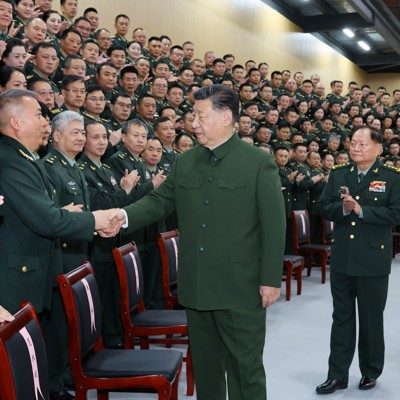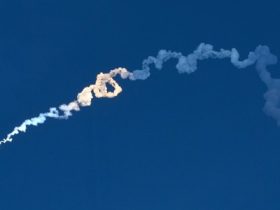In December 2024, Xi Jinping made a highly publicized visit to the PLA’s newly formed Information Support Force (ISF), underscoring its strategic importance to the People’s Liberation Army. The establishment of the force earlier that year marked a pivotal step in China’s evolving military strategy and Xi’s vision for the force. But what does its future hold? Recent PLA statements, exercises, and leadership directives provide essential clues about the nascent force’s likely trajectory.
The ISF’s primary mission is to build and operate a network information system that can support joint and multi-domain operations in any contested environment and under any enemy attack. According to PLA commenters, “success in modern warfare depends on the smooth flow of information,” making the network a cornerstone not just of conflict but of strategic competition.
The PLA is working toward systems-level integration and joint operations that require its communication and coordination channels to work in contested environments. To this end, the ISF is preparing to handle disruptions across multiple domains and conducting exercises under extreme conditions, such as repairing optical cables during simulated enemy attacks.
These drills test technical capabilities and help develop the resilience needed for the PLA’s anticipated combat scenarios. Future training will likely emphasize scenarios involving multi-vector attacks, requiring coordination between cyber, electronic warfare, and physical repair teams. This will also require intelligent monitoring systems and other advanced technologies to predict and mitigate potential disruptions.
Another recurring theme in PLA commentary—and of Xi’s visit—is the ISF’s directive to ensure integration across the military services and to improve joint operational capabilities. Interoperability has long been a challenge for the PLA, which has suffered from structural and operational fragmentation. The dissolution of the Strategic Support Force exposed inefficiencies in centralized structures, prompting the creation of the ISF as an independent entity alongside the Cyber Force and Aerospace Force. The ISF will help connect the former’s offensive capabilities with the latter’s surveillance and reconnaissance assets. In his visit, Xi highlighted the importance of such integration in modern warfare, where effective information flow and systems-level coordination are decisive factors.
During his inspection, Xi underscored another role for ISF: a driver of innovation and integrator of cutting-edge technologies such as artificial intelligence. For instance, the ISF’s responsibilities likely include overseeing the PLA’s Integrated Command Platform, a sophisticated system that helps coordinate joint forces with AI-driven decision-making tools and real-time data analysis to improve battlefield awareness. There are also efforts to integrate AI and quantum computing to bolster cryptographic security and accelerate decision-making processes.
The ISF is also concerned with big data, advanced cybersecurity measures, and unmanned systems. Chinese military commentators note that big data analytics is poised to anchor the PLA’s transition to “Intelligent Force Structuring.” By mining and analyzing vast datasets, the ISF can provide actionable intelligence to commanders, helping to predict enemy movements and optimize resource allocation.
PLA commentary has also increasingly emphasized “systems destruction warfare,” which prioritizes disabling adversarial networks while safeguarding one’s own systems. For the ISF, this means cyber defenses that ensure the resilience of critical infrastructure and communication networks. Platforms that use advanced cybersecurity technologies, like the Network Security and Defense Center, which likely falls under the ISF’s purview, are key to maintaining the PLA’s functionality during operations.
The ISF may also be tasked with integrating unmanned systems, including drones and autonomous vehicles, into its operational framework. Recent exercises demonstrated the PLA’s ability to coordinate real-time data from these assets, improving resilience and expanding operational capabilities.
China’s military-civil fusion strategy further supports the ISF’s development by using civilian expertise and firms in fields like artificial intelligence and big data. This approach mitigates personnel shortages in critical technical areas while accelerating the adoption of advanced technologies. Efforts to recruit graduates of elite universities exemplify how the PLA is trying to integrate civilian innovation into military operations.
The ISF faces challenges, though, in moving forward on this heady vision. The PLA’s centralized command culture may stifle innovation and rapid decision-making, particularly in a domain that thrives on agility. It is no mean feat to keep networks running under sustained cyber and electronic-warfare attacks. Nor is integrating new technologies such as AI-driven predictive analytics and automated network monitoring. Moreover, its rapid creation, so soon after the dissolution of the Strategic Support Force, suggests there may be a period of organizational instability, unclear chains of command, and gaps in capabilities during the transition. And while the ISF benefits from China’s military-civil fusion strategy, reliance on civilian expertise may expose vulnerabilities in times of heightened conflict.
As it begins to grapple with its missions, the ISF will likely prioritize several areas: building enhanced AI integration and autonomous decision-support systems for joint operations, expanding training regimens that emphasize realistic combat scenarios to prepare for hybrid threats, increasing collaboration with civilian tech sectors to accelerate innovation, creating advanced cyber defense mechanisms using next-generation tools to counteract quantum and AI-driven threats, ensuring continuity of operations under sustained and multifaceted attacks, and evolving its doctrine to refine its strategic approach to hybrid and informationized warfare. Whether it proves able to successfully balance these efforts will determine the true effect the new ISF will have on the PLA’s future capabilities.
Tye Graham is a Senior Researcher with BluePath Labs and a retired U.S. Army Foreign Area Officer.
P.W. Singer is Strategist at New America and the author of multiple books on technology and security, including Wired for War, Ghost Fleet, Burn-In, and LikeWar: The Weaponization of Social Media.
Read the full article here








Leave a Reply